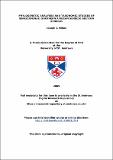Phylogenetic analyses and taxonomic studies of Senecioninae : southern African Senecio section Senecio
Abstract
Molecular phylogenetic analyses of subtribe Senecioninae, based on combining sequenced ITS and trnL-F fragments from specimens collected in the field with sequences collected from GenBank, suggest the subtribe is monophyletic, as is Senecio s.str. (including Robinsonia), and suggest an expanded monophyletic section Senecio. Many Senecio species should be removed from the genus, as they are only distantly related to it, emphasising the para- or polyphyletic nature of Senecio as it is currently circumscribed.
Area optimisation suggests southern Africa as a possible geographical origin for the genus and section. Harvey’s (1865) sectional classification of South African Senecio species (the only attempt to date to impose infrageneric groupings on these taxa), was tested for monophyly which, however, was not seen in the sections tested. A number of southern African species from Harvey’s sections are suggested for inclusion in an expanded section Senecio.
A clade suggested as basal to sect. Senecio, consisting of Senecio engleranus and Senecio flavus, was found to be only distantly related to the section. Resolution of the two species within the clade was not evident; a comparative study was therefore made employing RAPDs, morphometrics and breeding experiments. The two proved to be distinct entities, both genetically and morphologically, although they remain interfertile, suggesting that intrinsic postzygotic barriers between them are weak, and that hybridisation – not found in the wild - is mainly prevented by prezygotic barriers. F1 hybrids created between the two were seen to have intermediate morphologies and RAPD profiles. A single F1 individual self-pollinated to produce a vigorous F2 generation, allowing preliminary surveys of pollen number, pollen fertility and pappus type. Pappus type is seen to be under the control of allelic variations in a single major gene, while pollen numbers and pollen fertility are seen to be under more complex genetic control.
Type
Thesis, PhD Doctor of Philosophy
Collections
Items in the St Andrews Research Repository are protected by copyright, with all rights reserved, unless otherwise indicated.

